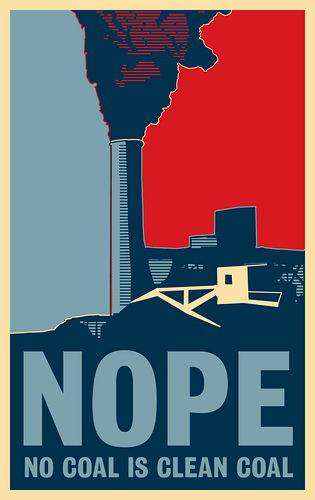While many environmental groups heralded Obama’s recent stimulus package as a major investment in a green future, they overlooked the stimulus’ $3.4 billion in so-called “clean coal” technologies, technologies that don’t exist and—truth be told—can’t exist. Because coal will never be clean.
The entire process of mining, transporting, washing, processing, and burning coal is incredibly dirty. Carbon capture and storage—if it ever can be developed in a cost-effective and environmentally sound manner—only addresses one small portion of coal’s dirty life cycle: the carbon emissions from the smokestacks. It does nothing to reduce mountaintop removal mining, sludge spills, dam breaches, poisoned wells, skyrocketing cancer rates, childhood asthma, premature deaths, slurry ponds, coal ash waste, mercury emissions, and the dozen other toxic pollutants and heavy metals spewing from smokestacks. All of these devastating effects of coal would likely increase if Obama and other “clean coal” propagandists increase our dependence on the planet’s dirtiest and most polluting fossil fuel.
Obama has also committed to reviving a boondoggle coal facility that even the Bush Administration decided to kill: the FutureGen Carbon Capture and Storage Plant, which just happens to be located in Obama’s home state of Illinois. Even though the facility costs have soared well beyond budget, and it is nowhere close to developing cost-effective technologies to safely capture and store carbon, Obama continues to support it.
Why are we letting Obama get away with greenwashing coal by perpetuating the “clean coal” myth? The Democrats received close to $1 million in “contributions” in 2008 from the coal mining industry. And southern Illinois is part of the country’s coal belt.
That may explain Obama’s pandering to the coal industry. But it doesn’t explain our own. Why are Americans—and even leading environmental groups—supporting a $3.4 billion stimulus for the coal industry?
Sadly, one reason may be geographic: most Americans—and certainly most politicians—don’t care about the Appalachians. The Tennessee sludge spill in December was the worst environmental disaster in American history—100 times larger than the Exxon Valdez. Yet the incident barely made national headlines.
Another reason, though, may be our own reluctance to change our reckless energy consuming habits. Coal is cheap and easy, and for most of us, its effects seem far away (though, in fact, coal is taking years off your life if you live in the South). The alternatives—solar, wind, geothermal, biomass, second-generation biofuels, and most importantly, energy conservation—require a lot more work, and most of us are too busy—or too lazy—to demand a truly green energy future.
If Obama succeeds with his “clean coal” rhetoric, everyone in our readership will suffer diminished health and quality of life. Tourism, recreation, add the long-term economic future of the region will be eviscerated by the effects of accelerated coal mining on the region’s natural resources.
But the flip-side is also true: we can lead the country—and the world—away from coal and onto a path of genuinely clean, renewable energy. In a twist of fate, the region’s most disenfranchised and forgotten people hold the key to the country’s future—and perhaps the planet’s as well. We can continue to be victims of coal, or the South can rise up once again. The people of the Southeast—especially mountain and mining communities across the Virginias—can rally behind a renewable energy future, or we can keep patting ourselves on the back for electing a black president and let him sell out our future to the coal industry.








